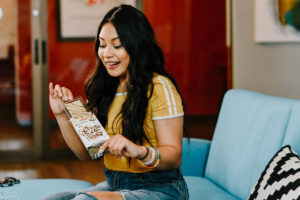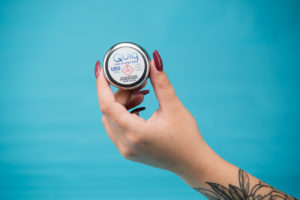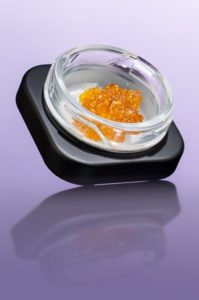Cannabis products can work wonders for your mental and physical wellbeing; but overconsumption can cause some uncomfortable effects, like paranoia and anxiety. However, those circumstances can be easily avoided by being an educated user. Here’s everything you need to know for safe consumption.
 First things first, let’s start with the stars of the show. The first is tetrahydrocannabinol, better known as THC, the psychoactive component responsible for the high. The greater the number of milligrams, the stronger the dose. A microdose is typically considered to be 2.5mg, and while this can be a bit much for some people, it may be an inconsequential amount to others. The second star is cannabidiol, CBD. When CBD is part of the show, it acts to subdue some of the psychoactive effects of THC, so an equal ratio of THC to CBD typically results in a smooth and more balanced experience. Consuming CBD on its own does not induce a “high”, rather most people feel calm and relaxed in the body with very little effect on the mental faculties.
First things first, let’s start with the stars of the show. The first is tetrahydrocannabinol, better known as THC, the psychoactive component responsible for the high. The greater the number of milligrams, the stronger the dose. A microdose is typically considered to be 2.5mg, and while this can be a bit much for some people, it may be an inconsequential amount to others. The second star is cannabidiol, CBD. When CBD is part of the show, it acts to subdue some of the psychoactive effects of THC, so an equal ratio of THC to CBD typically results in a smooth and more balanced experience. Consuming CBD on its own does not induce a “high”, rather most people feel calm and relaxed in the body with very little effect on the mental faculties.
Now it’s helpful to get clear on why you are consuming cannabis so you can choose the right form and method. Are you looking to alleviate a physical symptom that creates chronic pain or disability in your body? Or to sleep better or ease mental/physical stress such as tension or anxiety? Perhaps to feel a heightened connection with your spiritual nature? Or to simply elevate your experience of life? There are many reasons to consume and depending on your why, you may prefer Cannabis sativa or Cannabis indica, or a hybrid of both. Leafly does a great job of explaining the differences.
Now that you’re clear on your why, let’s talk about the what and how much. Cannabis is a substance in a league of its own, and affects everyone differently depending upon aspects such as the strain, the growing conditions of the plant, the delivery method, the overall physical makeup of the person consuming it, and the dose. A dose is the amount of the active constituents in a given product to be taken at one time, such as THC and/or CBD. Since each person will have a unique response, it’s important to spend some time to figure this out for yourself – no one can tell you with certainty how you will feel. Here’s a great resource for important general guidelines to best determine what dose and method to start with to safely consume.
 Below are the primary consumption methods, as well as some considerations to be aware of for each.
Below are the primary consumption methods, as well as some considerations to be aware of for each.
• Edibles (chocolates, gummies, tinctures, pills/capsules, full-spectrum oil, sprays): Edibles typically kick in between 45 and 60 minutes, sometimes up to 90 minutes after ingestion and last up to three to four hours, depending on the dose size and whether the stomach has food in it. Ideal for sustained effects, but know your dosage for safe consumption.
• Inhalation (vaping, dabbing, and smoking cannabis): Initial effect is within minutes, and peak effect in 20 to 30 minutes. The psychoactive effects diminish within 2 to 3 hours. Inhalation can be irritating to the lungs, but if you’re looking for a quick onset, this is an ideal option.
• Topicals (creams, salves, patches): These are absorbed through the skin and are ideal for localized issues. They are typically used to treat pain and are not ideal if you’re simply desiring to feel high. Patches release the dose over an extended period of time.
• Suppository (rectal, vaginal): Yes, you heard right! This consumption method is absorbed internally, not systemically, and has been reported not to cause intoxication. Learn more about suppositories for safe consumption here.
A rule of thumb for cannabis consumption is to “start low, go slow, then wait”. What this means is to consume a small amount at first in order to gauge your tolerance, then allow enough time to pass, 60-90 minutes, to see how you feel before taking an additional dose. Here are a couple of hacks to keep in your back pocket in case you accidentally consume too much.
 First, CBD has been known to attenuate the effects of THC (try a high-quality, reputable brand such as trupura CBD). Second, as strange as it sounds, suck on a black peppercorn. According to Weedmaps, in a 2011 review published by the “British Journal of Pharmacology,” researchers found that terpenes such as beta-caryophyllene, found in high amounts in peppercorn, tend to create a calming effect via the endocannabinoid system. Check out Safe Cannabis Use for more information on delivery methods.
First, CBD has been known to attenuate the effects of THC (try a high-quality, reputable brand such as trupura CBD). Second, as strange as it sounds, suck on a black peppercorn. According to Weedmaps, in a 2011 review published by the “British Journal of Pharmacology,” researchers found that terpenes such as beta-caryophyllene, found in high amounts in peppercorn, tend to create a calming effect via the endocannabinoid system. Check out Safe Cannabis Use for more information on delivery methods.
Also, it is less common, but some people lack the necessary enzyme in their liver to process THC when ingested through edibles. After being digested by the stomach, a more potent form of THC, 11-hydroxy-THC, which is a metabolic byproduct, is created as the THC is processed by the liver and GI tract. You’ll know you are one of these people lacking the enzyme to convert the THC to 11-hydroxy-THC if no matter how big the dose or how long you wait, you feel nothing. In this case, you’ll likely favor an inhalation method.
One final note to consider is instead of making homemade edibles, choose professionally-made, lab-tested edibles so you know how many milligrams you’ve consumed. Nearly all homemade edibles have an uneven distribution of cannabis throughout, so you truly will not know how much you’re consuming. It makes a BIG difference.
**Medical marijuana and cannabis products are not regulated by the United States Food and Drug Administration at this time. If you are pregnant or nursing, please visit the Centers for Disease Control and Prevention to understand the risks of consuming cannabis.
